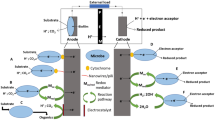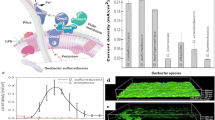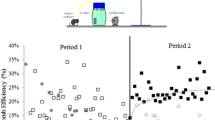Abstract
The effect of electron shuttles on electron transfer to microbial fuel cell (MFC) anodes was studied in systems where direct contact with the anode was precluded. MFCs were inoculated with Shewanella cells, and flavins used as the electron shuttling compound. In MFCs with no added electron shuttles, flavin concentrations monitored in the MFCs' bulk liquid increased continuously with FMN as the predominant flavin. The maximum concentrations were 0.6 μM for flavin mononucleotide and 0.2 μM for riboflavin. In MFCs with added flavins, micro-molar concentrations were shown to increase current and power output. The peak current was at least four times higher in MFCs with high concentrations of flavins (4.5–5.5 μM) than in MFCs with low concentrations (0.2–0.6 μM). Although high power outputs (around 150 mW/m2) were achieved in MFCs with high concentrations of flavins, a Clostridium-like bacterium along with other reactor limitations affected overall coulombic efficiencies (CE) obtained, achieving a maximum CE of 13%. Electron shuttle compounds (flavins) permitted bacteria to utilise a remote electron acceptor (anode) that was not accessible to the cells allowing current production until the electron donor (lactate) was consumed.





Similar content being viewed by others
References
Bennetto HP, Stirling JL, Tanaka K, Vega CA (1983) Anodic reactions in microbial fuel cells. Biotechnol Bioeng 25(2):559–568
Biffinger JC, Pietron J, Ray R, Little B, Ringeisen BR (2007) A biofilm enhanced miniature microbial fuel cell using Shewanella oneidensis DSP10 and oxygen reduction cathodes. Biosens Bioelectron 22(8):1672–1679
Bond DR, Lovley DR (2003) Electricity production by Geobacter sulfurreducens attached to electrodes. Appl Environ Microbiol 69(3):1548–1555
Bretschger O, Obraztsova A, Sturm CA, Chang IS, Gorby YA, Reed SB, Culley DE, Reardon CL, Barua S, Romine MF et al (2007) Current production and metal oxide reduction by Shewanella oneidensis MR-1 wild type and mutants. Appl Environ Microbiol 73(21):7003–7012
Cho EJ, Ellington AD (2007) Optimization of the biological component of a bioelectrochemical cell. Bioelectrochemistry 70(1):165–172
Du Z, Li H, Gu T (2007) A state of the art review on microbial fuel cells: a promising technology for wastewater treatment and bioenergy. Biotechnol Adv 25(5):464–482
Gil G-C, Chang I-S, Kim BH, Kim M, Jang J-K, Park HS, Kim HJ (2003) Operational parameters affecting the performance of a mediator-less microbial fuel cell. Biosens Bioelectron 18(4):327–334
Gorby YA, Yanina S, McLean JS, Rosso KM, Moyles D, Dohnalkova A, Beveridge TJ, Chang IS, Kim BH, Kim KS et al (2006) Electrically conductive bacterial nanowires produced by Shewanella oneidensis strain MR-1 and other microorganisms. PNAS 103:11358–11363
Gorby Y, Mclean J, Korenevsky A, Rosso K, El-Naggar MY, Beveridge TJ (2008) Redox-reactive membrane vesicles produced by Shewanella. Geobiology 6(3):232–241
Kim HJ, Park HS, Hyun MS, Chang IS, Kim M, Kim BH (2002) A mediator-less microbial fuel cell using a metal reducing bacterium, Shewanella putrefaciens. Enzyme Microb Technol 30(2):145–152
Lanthier M, Gregory KB, Lovley DR (2008) Growth with high planktonic biomass in Shewanella oneidensis fuel cells. FEMS Microbiol Lett 278:29–35
Lee H-S, Parameswaran P, Kato-Marcus A, Torres CI, Rittmann BE (2007) Evaluation of energy-conversion efficiencies in microbial fuel cells (MFCs) utilizing fermentable and non-fermentable substrates. Water Res 42:1501–1510
Liu H, Cheng S, Logan BE (2005) Production of electricity from acetate or butyrate using a single-chamber microbial fuel cell. Environ Sci Technol 39:658–662
Marsili E, Baron DB, Shikhare ID, Coursolle D, Gralnick JA, Bond DR (2008) Shewanella secretes flavins that mediate extracellular electron transfer. PNAS 105(10):3968–3973
Muyzer G, Ed W, Uitterrlinden A (1993) Profiling of complex microbial populations by denaturing gradient gel electrophoresis analysis of polymerase chain reaction-amplified genes coding for 16rRNA. Appl Environ Microbiol 59:695–700
Myers CR, Nealson KH (1988) Bacterial manganese reduction and growth with manganese oxide as the sole electron-acceptor. Science 240:1319–1321
Newman DK, Kolter R (2000) A role for excreted quinones in extracellular electron transfer. Nature 405(6782):94–97
Oh S, Logan BE (2005) Hydrogen and electricity production from a food processing wastewater using fermentation and microbial fuel cell technologies. Water Res 39(19):4673–4682
Park DH, Zeikus JG (2003) Improved fuel cell and electrode designs for producing electricity from microbial degradation. Biotechnol Bioeng 81(3):348–355
Picioreanu C, Head IM, Katuri KP, van Loosdrecht MCM, Scott K (2007) A computational model for biofilm-based microbial fuel cells. Water Res 41(13):2921–2940
Rabaey K, Boon N, Hofte M, Verstraete W (2005) Microbial phenazine production enhances electron transfer in biofuel cells. Environ Sci Technol 39(9):3401–3409
Reguera G, McCarthy KD, Mehta T, Nicoll JS, Tuominen MT, Lovley DR (2005) Extracellular electron transfer via microbial nanowires. Nature 435(7045):1098–1101
Ringeisen BR, Henderson E, Wu PK, Pietron J, Ray R, Little B, Biffinger JC, Jones-Meehan JM (2006) High power density from a miniature microbial fuel cell using Shewanella oneidensis DSP10. Environ Sci Technol 40(8):2629–2634
Roller SD, Bennetto HP, Delaney GM, Mason JR, Stirling JL, Thurston CF (1984) Electron-transfer coupling in microbial fuel cells: comparion of redox-mediator reduction rates and respiratory rates of bacteria. J Chem Technol Biotechnol 34 B(1):3–12
Schroder U (2007) Anodic electron transfer mechanisms in microbial fuel cells and their energy efficiency. Phys Chem Chem Phys 9:2619–2629
Shukla AK, Suresh P, Berchmand S, Rajendran A (2004) Biological fuel cells and their application. Curr Sci 87(4):455–468
Sund CJ, McMasters S, Crittenden SR, Harrell LE, Sumner JJ (2007) Effect of electron mediators on current generation and fermentation in a microbial fuel cell. Appl Microbiol Biotechnol 76(3):561–568
Tang YJ, Meadows AL, Keasling JD (2007) A kinetic model describing Shewanella oneidensis MR-1 growth, substrate consumption, and product secretion. Biotechnol Bioeng 96(1):125–133
Torres CI, Kato Marcus A, Rittmann BE (2007) Kinetics of consumption of fermentation products by anode-respiring bacteria. Appl Microbiol Biotechnol 77(3):689–697
von Canstein H, Ogawa J, Shimizu S, Lloyd JR (2008) Secretion of flavins by Shewanella species and their role in extracellular electron transfer. Appl Environ Microbiol 74(3):615–623
Zellner G, Neudörfer F, Diekmann H (1994) Degradation of lactate by an anaerobic mixed culture in a fluidized-bed reactor. Water Res 28(6):1337–1340
Zhang X-C, Halme A (1995) Modelling of a microbial fuel cell process. Biotechnol Lett 17(8):809–814
Acknowledgements
This work was supported by the Consejo Nacional de Ciencia y Tecnologia (CONACyT) via grant 196298 and by the Biotechnology and Biological Sciences Research Council (BBSRC) via grant BBS/B/03718. S. B. Velasquez-Orta appreciates the funding provided by the Postgraduate Researcher Development Programme in Newcastle University to conduct a Centre of Excellence Visit.
Author information
Authors and Affiliations
Corresponding author
Rights and permissions
About this article
Cite this article
Velasquez-Orta, S.B., Head, I.M., Curtis, T.P. et al. The effect of flavin electron shuttles in microbial fuel cells current production. Appl Microbiol Biotechnol 85, 1373–1381 (2010). https://doi.org/10.1007/s00253-009-2172-8
Received:
Revised:
Accepted:
Published:
Issue Date:
DOI: https://doi.org/10.1007/s00253-009-2172-8




